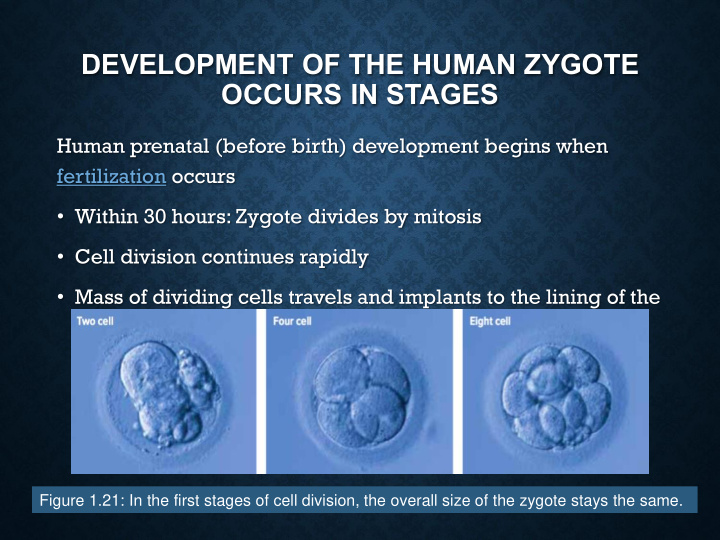



DEVELOPMENT OF THE HUMAN ZYGOTE OCCURS IN STAGES Human prenatal (before birth) development begins when fertilization occurs • Within 30 hours: Zygote divides by mitosis • Cell division continues rapidly • Mass of dividing cells travels and implants to the lining of the uterus Figure 1.21: In the first stages of cell division, the overall size of the zygote stays the same.
HUMAN PRENATAL DEVELOPMENT: EMBRYONIC AND FETAL STAGES • Embryonic stage: 8 weeks • Fetal stage: 30 weeks • Total: 38 weeks from fertilization to birth Figure 1.22: Human development from fertilized egg to newborn is divided into two main stages: embryonic and fetal.
HUMAN PRENATAL DEVELOPMENT • Complete chart and draw a diagram of what you think each stage looks like.
HUMAN PRENATAL DEVELOPMENT: SUMMARY
SEXUAL REPRODUCTION TAKES MANY FORMS. Sexual reproduction can vary based on: • Reproductive behaviors • Methods of fertilization (internal/external) • Ways that offspring develop (internal/external)
REPRODUCTIVE BEHAVIOURS • Organisms may have complex mating rituals which involve effort and energy expenditure. • Moonwalk • Dancing for your life? • Dancing Spider • Courtship • Puffer fish
SEXUAL REPRODUCTION FEATURES: MAMMALS • Development from fertilized egg to offspring occurs inside the female • Female is also source of nourishment
INSECTS • Reproduction in insects is usually sexual • Some insects (bees) develop without fertilization: • Unfertilized eggs become males • Fertilized eggs become females
FUNGI • Fungi (yeasts, moulds) reproduce sexually and asexually • Sexually (produce haploid spores)
FISH, FROGS, AND BIRDS • Fertilized eggs develop offspring outside the female’s body • Offspring are released when eggs hatch
PLANTS • Plants the grow from seeds require pollination for fertilization • Pollen can be transferred by the wind or by animals (bees, birds)
REPRODUCTIVE TECHNOLOGIES • What if a couple cannot have a child naturally? • Options that involve technology exist • In vitro fertilization
Recommend
More recommend